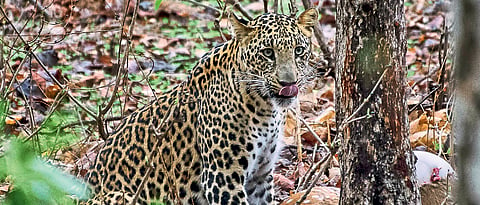

A visit to Pench National Park is exciting, engaging and enriching.
Teeming with lush teak and sal forests, water bodies and wildlife throughout, Pench Tiger Reserve is what inspired Rudyard Kipling to write Jungle Book.
A few hours’ drive from Nagpur, Pench is located in Seoni district of Madhya Pradesh.
As soon as you enter the Seoni area, you start seeing familiar names like Bagheera resort, Mowgli Jungle homes and so on. More amazing is the discovery that many places described in Jungle Book are for real -- like the Waingunga river with its gorge (where Sher Khan was killed), Kanhiwara village and the Seoni hills. That kind of sets the mood for things to come.
On the trail
And things come, in abundance. But firstly, when in Pench, remember that it is not just about tigers! Waking up to natural sounds, witnessing how the animal kingdom is perfectly in sync with sunrises and sunsets, sighting various interesting species during jeep safaris in the early morning and at sunset -- all these make up the experience.
By the law of probability, you have the highest chances of seeing a big cat in Pench National Park.
So there I was, at 5 am on the first day of our jungle excursion. Sitting in the open Gypsy car, we were all ears to capture the call of the deer and monkeys while our guide figured out which way the Tiger was headed.
A low growl had broken the silence and we quickly looked around.
False alarm. That was our stomach growling with hunger!
By now we had bumped into the occasional bisons grazing, wild boars chilling in the sun and the little jackal warily making its way but there was no sign of a tiger.
The second day went much like Day 1 -- my friends and I left no stone unturned in search of the big cat, but in vain!
Spotted!
On the third day though, as our Gypsy crawled a little deep into the wild, we noticed a spotted orange creature. Ok, that wasn’t a tiger but a beautiful leopard leaping ahead of us! I had never seen a wild predator this beautiful so up close and just to watch it for those few seconds was an experience of a lifetime for me!
We followed it for a while till we lost it in the thick jungle again. It was dragging its kill to safety!
Woah, we were just trying to believe that we had had a leopard sighting, which is rarer than a tiger sighting!
And at the end of the safari, we did see a tiger too, probably not exactly how we had imaged it to be. But I guess that’s why it is called ‘wild’, I mean you cannot predict a sighting with absolute surety. In retrospect, I got to experience more wildlife than I had even bargained for.
The excitement of hoping to have a sighting is quite addictive but apart from this, I also learnt to appreciate the forest, which was so serene and the landscape so beautiful. I can’t wait for the monsoons to get over -- yet another trip to my wilderness heaven beckons!
Key notes
The park is best visited from March to May for wildlife enthusiasts and from December to February for others. In winter, the temperature can plunge as low as 2° Celsius and during summer, it can soar up to 45° Celsius.
